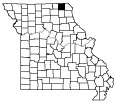Missouri Courthouses
Contact and other information about this county is available on the National Association of Counties website, http://explorer.naco.org/.
Editor's note
The PDF version of this publication includes illustrations. Select the “Download this publication” button.
 County: Scotland
County: Scotland
Organized: Jan. 29, 1841
Named after: Scotland, the European nation
County seat: Memphis
When Scotland County officials met to organize, they first assembled at a home near Millport, then met at Sand Hill, the first seat of justice. Memphis became the permanent county seat when Samuel and Lilly Cecil donated a site in 1843.
Charles Mety, superintendent of public buildings, provided the plans for Scotland County's first courthouse in February 1844. The court located the 25-by-36-foot, two-story, brick building one block north of the public square. The courtroom was on the first floor; five offices occupied the second story. William Staples of Monticello completed construction in June 1845 at a cost of $1,500. Ten years later the court considered the building unsafe. It stood until 1857.
The second courthouse, from 1856, occupied the public square. Levi J. Wagner, superintendent, presented several plans. The court selected those of Solomon Jenkins, who served as architect-contractor (Figure 1). Other Missouri courthouses by Jenkins include: Warren County, 1838; St. Charles County, 1849; and Callaway County, 1856. The Scotland County building measured about 40 by 70 feet and was constructed of locally made brick and dressed stone from the Des Moines River. Offices occupied the first floor, which was divided by crossing halls; the courtroom and jury rooms were on the second. Costs amounted to $19,500.
Figure 1
Scotland County Courthouse, 1856-1905. Architect: Solomon Jenkins (Courtesy: State Historical Society of Missouri)
Thirty years later the building seemed small because of increased population and county business, but the building continued in use until condemned May 16, 1905. The court considered repair work, but consulting architect Richard H. Phillips, St. Louis, estimated it would cost almost $7,000. He recommended a new building. The 1856 courthouse was razed in 1907 by John Scott, who bid $1,128. The weathervane and ball from the cupola were saved and placed on top of the water tank in Memphis.
Scotland County pointed with pride to the fact that when she was ready to build a 20th century courthouse, only one election was necessary to authorize funds for construction, in spite of a challenge for the seat from Gorin. This was in contrast to many counties, where often several elections failed before one finally succeeded. Scotland County judges had several architects' proposals from which to choose; they decided upon a plan from architect W. Chamberlain and Co., Birmingham, Alabama. Nothing is known of Chamberlain, and this is the only courthouse he built in Missouri.
Scotland County officials had interviewed about 10 architects, but many presented plans for buildings costing $85,000 to $125,000, far exceeding Scotland County's appropriation of $50,000. Among the examples of other courthouses Scotland County considered were: a proposed courthouse of Mercer County, Missouri; those constructed in Carroll and Hancock counties, Illinois, and courthouses in Davis, Decatur and Appanoose counties in Iowa.
Contract for the courthouse was awarded to the Falls City Construction Co., Louisville, Kentucky, in July 1907. For some unexplained reason, which puzzled the court judges, Falls City Construction Co. made the only bid. The company offered four options ranging in price from $47,700 for a pressed-brick building to $50,000 for a stone-veneered building with concrete base, slate roof, tin valleys and copper-covered dome. The court accepted the $50,000 option.
The building measured 101 by 77 feet at the base, and 80 feet to the top of the dome. To cut some expense, the court simplified the architect's plan by eliminating a dome over the curved end and reducing the number of clock faces: the basement story was raised, thus providing more usable space. Some people expressed concern about the small size of the courtroom. The Memphis Reveille believed it was a mistake to have a courtroom that would seat only 300. The paper said every county seat located in the country should have a courtroom that would seat 500.
The cornerstone was laid Oct. 22, 1907; the court accepted the completed building July 31, 1908.
Figure 2
Scotland County Courthouse, 1907-. Architect: W. Chamberlain and Co. (Courtesy: State Historical Society of Missouri)
Bibliography
Books
- History of Lewis, Clark, Knox and Scotland Counties. St. Louis: The Goodspeed Publishing Company, 1887.
Newspapers
- Memphis Reveille, May 16, 1905; Feb. 6-May 16, July 20, 25, Oct. 3, 10, 22, 24, 1907; Aug. 6, 1908.
Manuscript collections
- Work Projects Administration, Historical Records Survey, Missouri, 1935-1942. Scotland County. Located in Joint Collection: MU, Western Historical Manuscript Collection-Columbia and State Historical Society of Missouri Manuscripts.